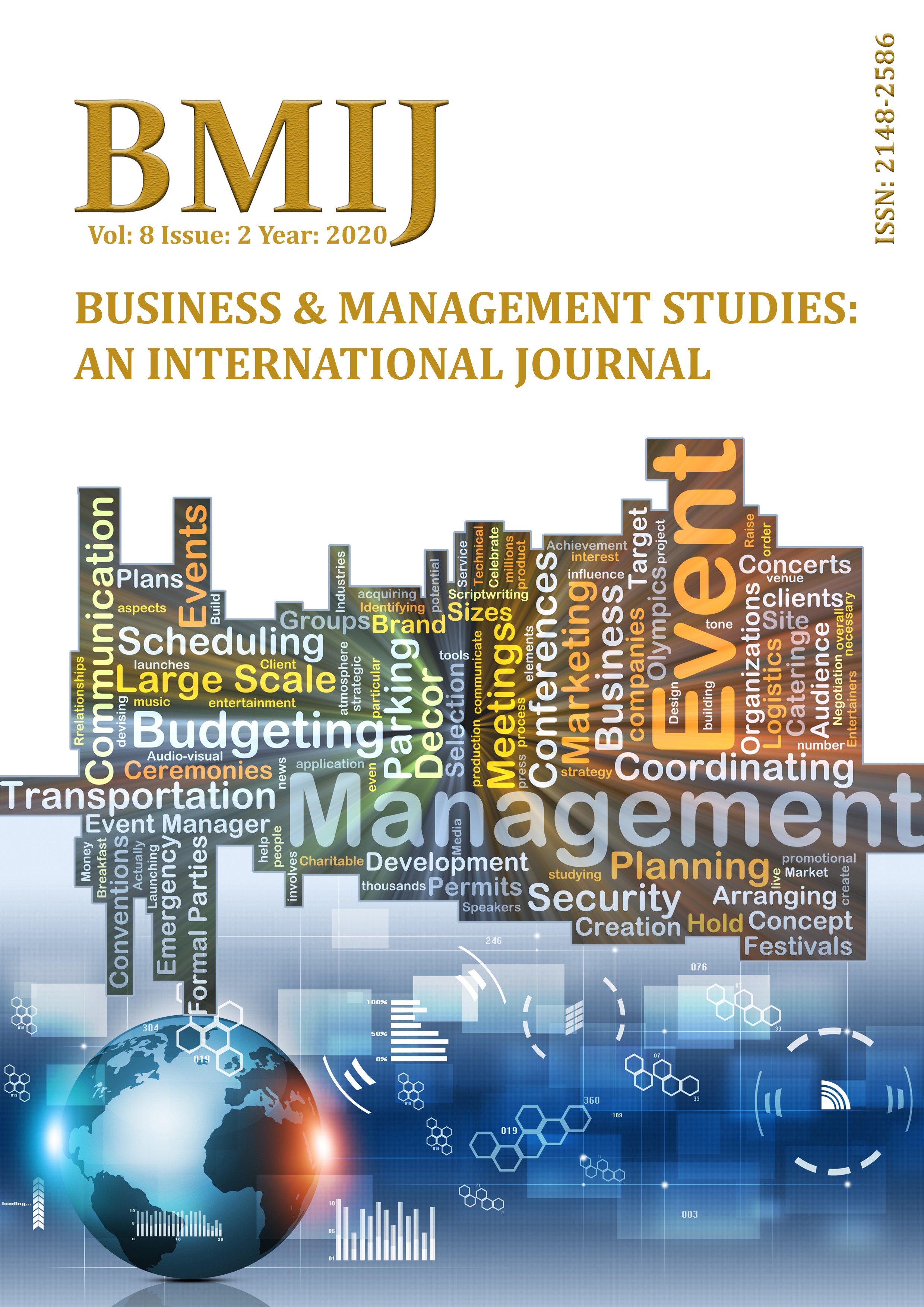
Yayınlanmış 25.06.2020
Anahtar Kelimeler
- Advertising, Marketing, Fear, Semiological Method
- Reklam, Pazarlama, Korku, Göstergebilimsel Yöntem
Nasıl Atıf Yapılır
Nasıl Atıf Yapılır
Öz
Pazarlama faaliyetlerinde sıkça yer alan ve yaşam boyu en çok karşılaşılan faaliyetlerden biri de şüphesiz reklamlardır. Reklam, markaların tutundurma karması araçları içerisinde; hedef kitleleriyle iletişim kurabilmek, etkileşim yaratabilmek ve potansiyel müşterilerini elde edebilmek için tercih ettiği pazarlama iletişim faaliyetlerindendir. Reklamlar izleyenlerin dikkatini çekme, ilgisini uyandırma, isteklendirme ve harekete geçirme amacı doğrultusunda sunulmaktadır. Bu doğrultuda reklamlar satın alma eğilimi gösteren tüketiciyi harekete geçirmede destekleyici rolü üstlenmektedir. Bu yönüyle reklamlarda yer alan kısa filmlerde, tüketicinin algısını markaya yönlendirmek için korku mesajları kullanılabilmekte ve başa gelmese bile gelmiş ya da gelecek gibi düşündürmekte oldukça etkili olabilmektedir. Bir pazarlama stratejisi olan korku pazarlamasını kullanan markalar bu konuda insanların bilinçaltına inerek onlarda korku duygusu yaratarak satın almaya yönlendirmeyi amaçlamaktadır. Bu çalışma; reklamlarda korku mesajlarının nasıl işlendiğini ortaya koymak, korku pazarlamasının tüketiciler üzerinde yaratmaya çalıştığı etki, reklamlarda verilen korku mesajlarının ardındaki gerçeği anlama ve yorumlamasını amaçlamaktadır. Çalışmada göstergebilimsel yöntem kullanılmıştır.
Referanslar
- Agocuk, Pelin, (2013). “Amarcord Filmi Özelinde Göstergebilimsel Film Çözümlemesi ve Anlamlandırma”, Uluslararası Sosyal Araştırmalar Dergisi, 7(31), 7-18.
- Akbayır, M. (2017). “Bir Göstergebilimsel Analiz Örneği: The Watchtower of Turkey”, International Congress Of Eurasian Social Sciences (ICOESS) Özel Sayısı, 8(28).
- Alexander, J. W. (2015). “Medicating the Salaryman Lifestyle: Fear-Based Marketing of Liver Stimulant Drugs in Postwar Japan”, Japan Forum, 27(2) 134-166.
- Anadolu Sigorta Reklam Filmi, https://youtu.be/DWIcMrmGM_E, Erişim tarihi: 13.04.2019
- Balcı, Ş. (2007). “Negatif Siyasal Reklamlarda İkna Edici Mesaj Stratejisi Olarak Korku Çekiciliğinin Kullanımı”, Selçuk Üniversitesi Sosyal Bilimler Enstitüsü Dergisi, 17, 73-106.
- Barthes, R. (1993). Göstergebilimsel Serüven, M. Rifat ve S. Rifat (Çev.), İstanbul: Yapı Kredi Yayınları.
- Belch, G. E. & Belch, M.A (2007). Advertising and Promotion: an Integrated Marketing Communications Perspective. 7th Ed., New York: Mcgraw-Hill/Irwin. http://182.160.97.198:8080/xmlui/handle/ 123456789/54.
- Brooker, G. (1981). “A Comparison Of The Persuasive Effects Of Mild Humor And Mild Fear Appels”. Journal of Advertising, 10(4), 29-40.
- Chitty, W., Barker, N., Chitty, B., Valos, M. & Shimp, T.A. (2011). Integrated Marketing Communications (3rd ed.). South Melbourne, Vic. : Cengage Learning.
- Çakar, S. (2009). Reklamlarda Korku Çekiciliğinin Kullanılması, Bahçeşehir Üniversitesi Sosyal Bilimler Enstitüsü Reklamcılık Yüksek Lisans Programı, Yayınlanmamış Yüksek Lisans Tezi, İstanbul.
- Dean, D. (2005). “Fear, Negative Campaigning and Loathing: The Case of the UK Election Campaign”, Journal of Marketing Management, 21, 1067-1078.
- Dometos Reklam Filmi, https://youtu.be/AyLxRbXt8s8, Erişim tarihi: 12.04.2019
- Elden, M., Ulukök, Ö. & Yeygel, S. (2005). Şimdi Reklamlar… İstanbul: İletişim Yayınları.
- Erdoğan, İ. & Alemdar, K. (2005). Öteki Kuram: Kitle İletişim Kuram ve Araştırmalarının Tarihsel ve Eleştirel bir Değerlendirilmesi. Ankara: Erk Yayınları.
- Fırat, D. (2013). “Korkunun Bir Pazarlama Aracı Olarak Uygulanması: İşletmelerin Korku Mesajları İle Tüketicilerin Algısı Arasında Uyum Var Mı?”, Sosyal ve Beşeri Bilimler Dergisi, 5(1), 187-197.
- Fırat, D. & Yıldız, Y.G. (2019). “Reklamlarda Kullanılan Korku Öğesine Karşı Tüketicilerin Sergilemiş Olduğu Tutumlar”, Gümüşhane Üniversitesi Sosyal Bilimler Enstitüsü Elektronik Dergisi, 10(1), 203-219.
- Gass, R. & Seiter J.S. (2003). Persuasion, Social Influence and Compliance Gaining. New York, Ny. https://books.google.com.tr/books.
- Hovland, C.I., Janis, I.L.& Kelly, H.H. (1953). Communication and Persuasion, New Haven: Yale University Press.
- Imbraile, R. (2007). Motivasyon Temelli Pazarlama. Serkan Köse (Çev.). İstanbul: Kapital Medya Yayıncılık.
- ING Bankası Reklam Filmi, https://youtu.be/KoNyc1UHiWI, Erişim tarihi: 12.04.2019
- Kaftandjiev, C. & Shustova, E. (2018). “Fear Appeals in Marketing Communications of Banks and Insurance Companies in the Continuum of Dramatic-Tragic Situations–The Semiotic Perspective”, International Review, (1-2), 83-110.
- Kaya, İ. (2009). Pazarlama Bi Tanedir, İstanbul: Babıali Kültür Yayınevi.
- Kocabaş, F. & Elden, M. (2006). Reklamcılık Kavramlar, Kararlar, Kurumlar. İstanbul: İletişim Yayınları.
- Krishen, A. S., & Bui, M. (2015). Fear Advertisements: Influencing Consumers to Make Better Health Decisions. International Journal of Advertising, 34(3), 533-548.
- Lennon, R. Rentfro, R. & O’Leary, B. (2010). “Social Marketing and Distracted Driving Behaviors Among Young Adults: The Effectiveness of Fear Appeals”, Academy of Marketing Studies Journal, 14(2), 95-113.
- Leventhal, H. (1970). “Findings And Theory İn The Study of Fear Communications Advances in Experimental Social Psychology”, Published by Elsevier, 5, 119-186. Doi: 10.1016/S0065-2601(08)60091-X.
- Manyiwa, S. & Brennan, R. (2012). “Fear Appeals in Anti-Smoking Advertising: How Important is Self-Efficacy?”, Journal of Marketing Management, 28(11-12), 1419-1437.
- Marc Reklam Filmi, https://youtu.be/u8TURDpMwtU, Erişim tarihi: 10.04.2019
- Milupa Aptamil Reklam Filmi, https://youtu.be/Lotman_jwnQ, Erişim tarihi: 11.04.2019
- Molped Reklam Filmi, https://youtu.be/otDiFvHvk_I, Erişim tarihi: 12.04.2019
- Mostafa, M.M. (2020). “Neural Correlates of Fear Appeal in Advertising: An fMRI Analysis”, Journal of Marketing Communications, 26(1), 40–64.
- Özer, E.Z. & Aksoy, M. (2018). “ Korku Çekiciliğinin Gıda Korkusu Üzerine Etkisi”, Journal of Tourism and Gastronomy Studies, 6(3), 359-369.
- Öztürk, U. & Sevinç, H. (2017). “Korku Pazarlama Çerçevesinde Suriye Hükümeti’nin Silah İthalatını Arttıran Etkenler”, Uluslararası Sosyal Araştırmalar Dergisi, 10(54), 890-898.
- Parodontax Reklam Filmi, https://youtu.be/tsBZM9I2Cbg, Erişim tarihi: 12.04.2019
- Pronet Reklam Filmi, https://youtu.be/SFWS4JAWSVY, Erişim tarihi: 13.04.2019
- Prozinc Plus Reklam Filmi, https://youtu.be/86dYrJdMb-I, Erişim tarihi: 14.04.2019
- Rexona Reklam Filmi, https://youtu.be/T1X8Tws7IME, Erişim tarihi: 14.04.2019
- Rogers, R.W. (1975). “Protection Motivation Theory of Fear Appeals And Attitude Change”, The Journal of Psychology, 91(1), 93-114.
- Sarıyer, N. (2019). “Korkunun Satın Alma Duyarlılığına Etkisi-Netnografik Bir Çalışma”, 4th International Symposium on Innovative Approaches in Social, Human and Administrative Sciences, SETSCI Conference Proceedings, 4(8), November 22-24, Samsun, Turkey. 271-276.
- Wells, W., Morıarty, S., Burnett, J. (2006). Advertising Principles And Practice. 9. Baskı. Pearson Prentice Hall.
- Williams, K.C. (2012). “Fear Appeal Theory”. Research in Business and Economics Journal, 5(1), 1-21.
- Witte, K. (1994). “Fear Control And Danger Control: A Test of The Extended Parallel Process Model (Eppm)”, Communication Monographs, 61(2), 113-134.



